Gold Empress Josephine Gown
This gown was created to wear at a Masquerade ball. It was inspired by a portrait of the Empress Josephine wife of Emperor Napoleon it was painted by François Gérard in 1801. Empress Josephine was a great fashion leader. She was an ideal model for the slender fashions of the day. Many of her Regency fashion dresses were created by the designer Leroy.
(The model in the photograph on the left wearing the gown is called Delphine. She is French and I think the dress suits her very well!)
Napoleon Bonaparte was crowned Emperor in 1804 and was keen to make France a leader of fashion and innovator of design and craft skills. During the French Revolution the French textile industry had suffered and unlike in England, use of textile machinery had been non existent. Emperor Napoleon stopped the import of English textiles and he revived the Valenciennes lace industry so that fine fabrics could be made there.
To make women buy more material he forbade them to wear the same dress more than once to court. Ladies dresses had extra fabric gathered into the back and trains were seen again for evening. Bonaparte also had fireplaces at the Tuileries blocked up so that ladies would wear more clothing.
The high waisted graceful styles of early 19th century are known as the Empire style. The Empire dress which evolved in the late 1790s began as a chemise shift gathered under the breasts and at the neck. By 1799 the empire line silhouette was well established and is the line we associate with dress of the early 1800s.
Named after The First Empire, by 1800 the gown silhouette had a very décolleté low square neckline and a short narrow backed bodice attached to a separate skirt.
This regency gown is made from beautiful gold satin lined with lightweight cotton. The gold fabric is ideal to create a dress which would be worn at a glittering ball.
The bodice is cut high in fact the natural waist was actually completely neglected and the dresses were cut right underneath the breasts. The neckline is cut low with a décolleté at the front and cut higher at the back. The front of the bodice is cut in one section – it has small darts at the front to create shaping under the bust whilst the back of the gown is cut in shaped sections. The gown is fastened at the back by hooks and eyes. A regency corset could be worn for support if the wearer was large chested. So it could be said that a kind of push-up bras was invented during this period. There was actually a corset which covered only the breasts and ended far above the waist. It was used to flatten the area covered by the dress and lift the parts that (in some cases) “popped” out of the décolleté. The seams under the bust have been edged with gold braid and gold lace trims the neckline.
The skirt is long and attached under to the bodice under the bust to create the famous empire line. The skirt has been cut in three sections – one front and two back. It is cut in a slight ‘A’ line to create a nice flow to the hem. The bottom of the skirt has been finished by adding a gold lace trim to the hem. The skirt has been lined with white cotton lawn.
The sleeves are made in two parts. Although short sleeves were preferred the longer version was needed in colder seasons.
A tighter fitting under sleeve forms the base for the top sleeve. This top sleeve is cut much larger than the base so when the top and bottom edges are gathered they give the ‘puffed’ effect so favoured at this time. The sleeves have been trimmed with gold braid that matches the gown.
A deep claret velvet robe is worn over the gown. It is sleeveless and would always be worn with and to compliment the gown underneath, it has been cut in the same empire style. The bodice front is cut in two pieces which are darted for shaping. The back should have been cut in one piece however due to the width of the fabric it has been sewn with a seam at the back. It has been gathered onto the bodice. The lower part has been cut to create an attractive train. The train was originally much longer but was found to be difficult to wear so has been reduced to a more manageable size. The robe is lined with very heavy purple satin which creates weight and is an attractive contrast to the velvet. It is trimmed with sumptuous gold guipure lace and lavishly embellished with gold embroidery and gold spangles. A fashion for military touches persisted at this time so many coats, robes and outer garments were covered in decorative braids, tassels, frogging and cords, as a result their wearers looked like members of the Hussars.
The necklace has been created from pearls, gold filigree beads hand strung with gold plated wire. It has a beautiful cameo pendant attached and is fastened with a gold ribbon. The gown is worn with white opera length gloves. White gloves were always worn for formal occasions, no other colours were worn.
Napoleonic and Regency – as this period was called in England. Was the era Jane Austen wrote about. Ladies wearing long gloves are often to be seen in films made of her books, such as “Sense and Sensibility” and “Emma”.
A fan would always be carried at a ball. This Battenberg lace fan has wooden spines and pretty lace panels with delicate embroidery. It is authentic to the period. I bought this fan from the Jane Austen Society and very pretty it looks! It In the past, hand fans were used not only as cooling instruments, but also as convenient communication devices, mainly for transmitting more or less furtive love messages
For balls headdresses trimmed with large feathers were very popular. The headdress worn here is created from a golden coloured headband. It is decorated with a gold butterfly embellished with pink jewels and decorated with lavish ostrich feathers in shades of white, gold, purple and claret.
This sumptuous and glittering masquerade costume is fit for an Empress.
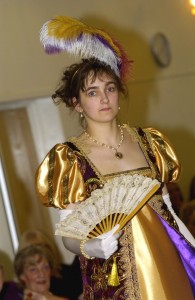
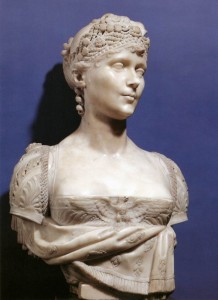
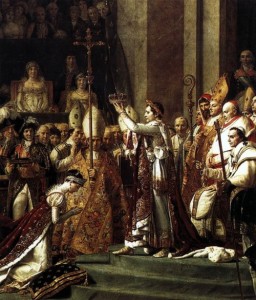
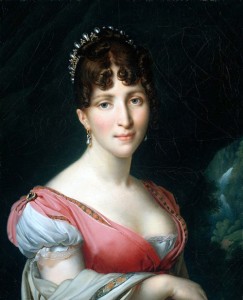
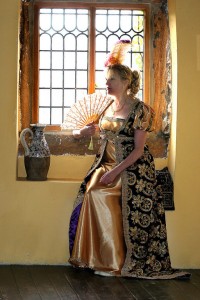

I have always wanted to wear a costume like this to a special occasion – it’s beautiful!
Great post. I love this dress as I am interested in Empress Josephine – fabulous! Thank you and best of luck.